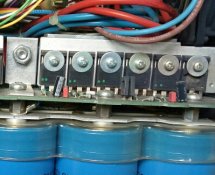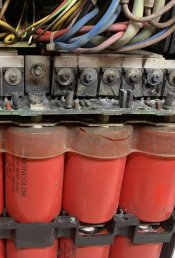Hi,
Hope someone can help me.
I have an old Broncolor Grafit studio power pack/generator that I would like to repair myself. (Note: I have experience with flash electronics, high voltages and lethal capacitors).
The previous owner advised me that after storage the pack was tested and popping sounds were heard. I have opened the unit and discovered that one IGBT has exploded and others are damaged. Fortunately the IGBTs are a common type and are available from Mouser/Digikey.
The display and controls work OK however the caps dont charge and the display shows avail power of '0'.
Whilst I can simply replace the IGBTs I am unsure what may have caused the IGBT failures and am seeking tips from anyone who has repaired one of these units before.
I have seen another Grafit pack with similar IGBT damage so assume that this failure mode may be well known to techs.
The capacitors look physically ok however I will check the ESR of each cap during my repair. After repair I will carefully and slowly reform the caps.
(Of course I keep the caps shorted when not being tested or reformed).
As the unit isnt charging the capacitors I suspect that the charging circuits may also be damaged.
Can anyone offer service tips?
(I am a non-commercial/art photographer so cannot afford to have this unit serviced by an authorised repairer. My only hope is that I can repair this myself).
Many thanks
Emulsion.
Hope someone can help me.
I have an old Broncolor Grafit studio power pack/generator that I would like to repair myself. (Note: I have experience with flash electronics, high voltages and lethal capacitors).
The previous owner advised me that after storage the pack was tested and popping sounds were heard. I have opened the unit and discovered that one IGBT has exploded and others are damaged. Fortunately the IGBTs are a common type and are available from Mouser/Digikey.
The display and controls work OK however the caps dont charge and the display shows avail power of '0'.
Whilst I can simply replace the IGBTs I am unsure what may have caused the IGBT failures and am seeking tips from anyone who has repaired one of these units before.
I have seen another Grafit pack with similar IGBT damage so assume that this failure mode may be well known to techs.
The capacitors look physically ok however I will check the ESR of each cap during my repair. After repair I will carefully and slowly reform the caps.
(Of course I keep the caps shorted when not being tested or reformed).
As the unit isnt charging the capacitors I suspect that the charging circuits may also be damaged.
Can anyone offer service tips?
(I am a non-commercial/art photographer so cannot afford to have this unit serviced by an authorised repairer. My only hope is that I can repair this myself).
Many thanks
Emulsion.






